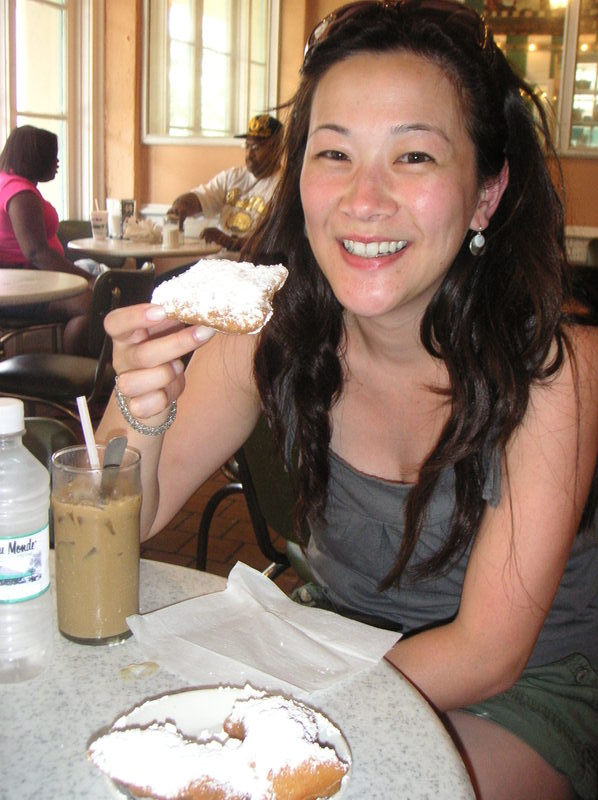This is the final post in the series. If you haven't already, make sure you get a chance to see The Fall of the Hornworm and The Life of the Argiope aurantia posted last week. It's been fascinating stuff in the Greenish Thumb garden! Above and below, a monarch caterpillar we found on the asclepias outside. I knew I kept this old butterfly house for a reason!

We used a plastic carry out soup container, filled it with water, put the lid on, and cut some holes out of the top. The butterfly weed cuttings stayed fresh in this little vase throughout the project.

After a few days of hearty eating, we read that there should be a stick or something for the butterfly to hang in it's chrysalis form on. When it begins to circle the top (which it did for about half a day), be ready for the big switcheroo!
The caterpillar didn't bother using the stick to hang from. Instead, it made a webbing right across the vinyl top of the butterfly house. Notice the little dot of concentrated webbing by the mouth (towards the right). There's probably a scientific name for this, but I'm learning experientially this time - and not from a book. I'm calling it "glue".
Notice that now, the caterpillar has switched sides. The back end is now on the "glue". At this point, I've been setting my timer to remind me to check on progress every 20 minutes.
Above: starting to unstick its little leg suction cups. Below: he let go all at once and swung for a few moments.
At this point, I'm getting really excited. The timer's still going off every 20 minutes. BUT...this J-shaped hanging stage lasts for about 16 hours!
Unfortunately, the process which took the caterpillar from the photo above to the photo below, was faster than the time it took me to cut up some onions for dinner. I missed the part I was looking most forward to!!!
20 minutes elapsed between the photo above and below.
For most of the next several days, the chrysalis looked as it does below.
It was about 10pm many days later when I noticed some indication of the final stage.
The next morning, probably about...11am or so, the butterfly emerged. No one was home to witness the process, but I can tell you it was just as exciting to find the chrysalis like it looks below and then to spot the huge butterfly pumping its wings.
On our first attempt to release the butterfly, the butterfly fell to the bottom of the cage, ended up on its side, and stopped moving completely. Its legs were folding in like a dead spider's. It was almost a very sad day with lessons I did not want to be teaching the kids about the (extremely fleeting!) cycle of life. We mournfully brought it back inside. After about 10 minutes of worry, just staring at it, it came back to life! There was a major storm headed our way so we kept it inside for the next day and a half. We cut off a butterfly bush bloom, some other flowers, a little dish of sugar water, and a little piece of fruit. We had no idea what to provide for it so we thought we'd cover all our bases! I would have researched this, but I tell ya, between the weather reports and the stress of the back-from-the-dead act, time was of the essence. I did NOT want the butterfly to starve to death after this whole ordeal! It was a nerve wracking couple of days.
On the next clear day, the butterfly was ready to leave for Mexico!
This map below from the USGS National Atlas, shows where our butterfly and others will overwinter.

And to leave you with something light:
Q: Why did the boy throw a stick of butter off the mountain?
A: He wanted to see the butterfly!






































This is amazing. Try as I might to get caterpillars to call the garden home I just can't seem to attract them. I've been trying for years to create a post like this, but it just hasn't worked. Maybe I'm just not that good at spotting them in the garden.
ReplyDeleteGreat work on the post.
Hahaha Wendy, that is an absolutely nice tale of a butterfly's life cycle. However, i agree, the most important photo/change was not seen, as if all of us are asking, how did that happen? And the adult butterfly coming out of the exoskeleton is also a very important change which should have been documented. Maybe another caterpillar is needed to fill that gap! hahaha. But your annotation is great and photos are great, including the expression from your daughter. I love it.
ReplyDeleteI love how you documented the whole process! That was so awesome! What a great project for the kids to observe!
ReplyDeleteYou had me spellbound, Wendy. What a fabulous post. I always wanted to do this with my kids but monarchs just aren't all that common around my neck of the woods. [Could try swallowtails I suppose.] How wonderful that your daughters were able to witness this and that everything turned out so well.
ReplyDeleteYour pictures are so descriptive... I could just follow the whole process by just looking at your pictures. I am also in awe how God created such a magical process ;-)
ReplyDeleteI can't believe that you missed the same part of the process that I missed when photographing my monarch. that phase has always baffled me and i guess for the time being, it will continue to do so. Thanks for the photographs.
ReplyDeleteIt's awesome that you get to document the whole process of a caterpillar turning into a butterfly, Wendy.
ReplyDeleteI tried to do similarly but I ended up with a dead caterpillar on the 4th day. It made me feel so guilty for killing it. I didn't know what went wrong. Since then I stop capturing anymore caterpillar. Seeing how your children enjoy the whole observation, I would certainly enjoy and get all over excited over the metamorphosis.
My garden, especially my Adenium and lime plants are now invaded by caterpillars. Grrrrhhh....they have turned my Adenium bald and ugly with patches of holes here and there. I am not even sure if I like caterpillar or butterfly anymore...grrrrh.....
This process of the transformation from squishy caterpillar to a winged beauty always makes me feel like something miraculous could happen to me if I ate the right amount of greenery. But it never does... No wings. Just green things stuck in my teeth. Sorry...I am just in a strange commenting mode today.
ReplyDeleteYour daughters look enthralled with this whole process. Thanks for sharing.
Aww... that must have been really an exciting process... Love the way you put everything together. It's so cute. At first, I thought I misread when you mentioned that the butterfly was leaving for Mexico. :) You could be right.
ReplyDeleteWendy, this is fabulous! I'm so happy you all were able to watch (a lot) of this wonderful transformation! It's difficult to see every single step along the way. I haven't had monarchs lay eggs on my milkweed this year, but the swallowtails sure did. I captured some of the stages but wasn't home for the development of the pupas or the emergence from the pupa. Your photos are great! Congrat's on being able to see these with your kids;-)
ReplyDeleteYou have smartly documented the whole caterpillar transformation! It's like watching Animal plant's - survival series!
ReplyDeleteYour daughters will not soon forget this science project. You get the 'Mom of the Year' prize.
ReplyDeleteAmazing isn't it. Its a good thing that you kept the caterpillar separately and fed it. Leaving it on a plant might be disasterous.
ReplyDeleteAbove all, its so wonderful a feeling to set a butterfly free.
How fun and what a fantastic post!
ReplyDeleteOh Wendy, there is something magical about seeing a butterfly morph from a creepy caterpillar to a lovely beautiful. It must have been a touching moment seing the butterly come to live again and flying freely out into the world, all on its own. This is something I always wanted to do. Until now, I don't know where my caterpillars go to when they form into a chrysalis.
ReplyDeleteThey are just the most amazing looking caterpillars. I've seen a few people post on them. Australia just doesn't have anything to compare. I must log back in tomorrow and show this post to my daughter.
ReplyDelete